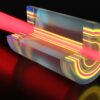It may seem like technology advances year after year, as if by magic. But behind every incremental improvement and breakthrough revolution is a team of scientists and engineers hard at work.
UC Santa Barbara Professor Ben Mazin is developing precision optical sensors for telescopes and observatories. In a paper published in Physical Review Letters, he and his team improved the spectra resolution of their superconducting sensor, a major step in their ultimate goal: analyzing the composition of exoplanets.
“We were able to roughly double the spectral resolving power of our detectors,” said first author Nicholas Zobrist, a doctoral student in the Mazin Lab.
“This is the largest energy resolution increase we’ve ever seen,” added Mazin. “It opens up a whole new pathway to science goals that we couldn’t achieve before.”
The Mazin lab works with a type of sensor called an MKID. Most light detectors—like the CMOS sensor in a phone camera—are semiconductors based on silicon. These operate via the photo-electric effect: a photon strikes the sensor, knocking off an electron that can then be detected as a signal suitable for processing by a microprocessor.
An MKID uses a superconductor, in which electricity can flow with no resistance. In addition to zero resistance, these materials have other useful properties. For instance, semiconductors have a gap energy that needs to be overcome to knock the electron out. The related gap energy in a superconductor is about 10,000 times less, so it can detect even faint signals.
What’s more, a single photon can knock many electrons off of a superconductor, as opposed to only one in a semiconductor. By measuring the number of mobile electrons, an MKID can actually determine the energy (or wavelength) of the incoming light. “And the energy of the photon, or its spectra, tells us a lot about the physics of what emitted that photon,” Mazin said.
Leaking energy
The researchers had hit a limit as to how sensitive they could make these MKIDs. After much scrutiny, they discovered that energy was leaking from the superconductor into the sapphire crystal wafer that the device is made on. As a result, the signal appeared weaker than it truly was.
In typical electronics, current is carried by mobile electrons. But these have a tendency to interact with their surroundings, scattering and losing energy in what’s known as resistance. In a superconductor, two electrons will pair up—one spin up and one spin down—and this Cooper pair, as it’s called, is able to move about without resistance.
“It’s like a couple at a club,” Mazin explained. “You’ve got two people who pair up, and then they can move together through the crowd without any resistance. Whereas a single person stops to talk to everybody along the way, slowing them down.”
In a superconductor, all the electrons are paired up. “They’re all dancing together, moving around without interacting with other couples very much because they’re all gazing deeply into each other’s eyes.
“A photon hitting the sensor is like someone coming in and spilling a drink on one of the partners,” he continued. “This breaks the couple up, causing one partner to stumble into other couples and create a disturbance.” This is the cascade of mobile electrons that the MKID measures.
But sometimes this happens at the edge of the dancefloor. The offended party stumbles out of the club without knocking into anyone else. Great for the rest of the dancers, but not for the scientists. If this happens in the MKID, then the light signal will seem weaker than it actually was.
Fencing them in
Mazin, Zobrist and their co-authors discovered that a thin layer of the metal indium—placed between the superconducting sensor and the substrate—drastically reduced the energy leaking out of the sensor. The indium essentially acted like a fence around the dancefloor, keeping the jostled dancers in the room and interacting with the rest of the crowd.
They chose indium because it is also a superconductor at the temperatures at which the MKID will operate, and adjacent superconductors tend to cooperate if they are thin. The metal did present a challenge to the team, though. Indium is softer than lead, so it has a tendency to clump up. That’s not great for making the thin, uniform layer the researchers needed.
But their time and effort paid off. The technique cut down the wavelength measurement uncertainty from 10% to 5%, the study reports. For example, photons with a wavelength of 1,000 nanometers can now be measured to a precision of 50 nm with this system. “This has real implications for the science we can do,” Mazin said, “because we can better resolve the spectra of the objects that we’re looking at.”
Different phenomena emit photons with specific spectra (or wavelengths), and different molecules absorb photons of different wavelengths. Using this light, scientists can use spectroscopy to identify the composition of objects both nearby and across the entire visible universe.
Mazin is particularly interested in applying these detectors to exoplanet science. Right now, scientists can only do spectroscopy for a tiny subset of exoplanets. The planet needs to pass between its star and Earth, and it must have a thick atmosphere so that enough light passes through it for researchers to work with. Still, the signal to noise ratio is abysmal, especially for rocky planets, Mazin said.
With better MKIDs, scientists can use light reflected off the surface of a planet, rather than transmitted through its narrow atmosphere alone. This will soon be possible with the capabilities of the next generation of 30-meter telescopes.
The Mazin group is also experimenting with a completely different approach to the energy-loss issue. Although the results from this paper are impressive, Mazin said he believes the indium technique could be obsolete if his team is successful with this new endeavor. Either way, he added, the scientists are rapidly closing in on their goals.
More information:
Nicholas Zobrist et al, Membraneless Phonon Trapping and Resolution Enhancement in Optical Microwave Kinetic Inductance Detectors, Physical Review Letters (2022). DOI: 10.1103/PhysRevLett.129.017701 . On Arxiv: arxiv.org/abs/2204.13669
Provided by
University of California – Santa Barbara
Citation:
Keeping the energy in the room (2022, July 1)



